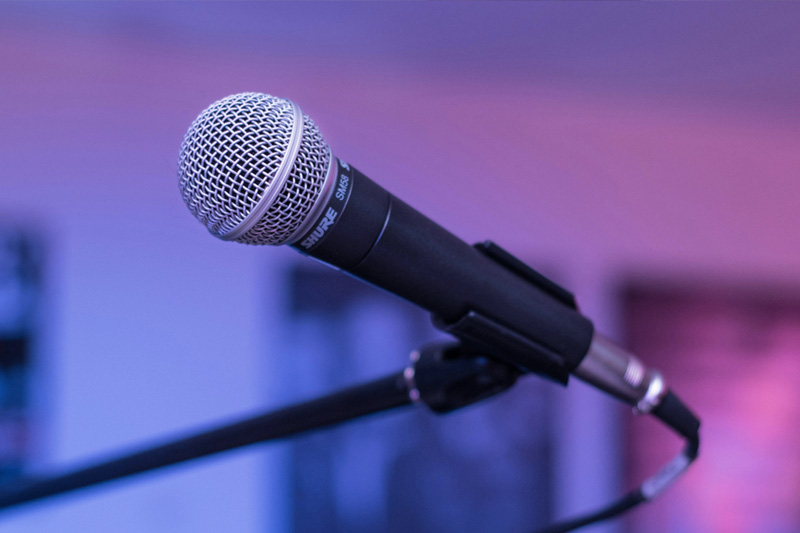
Creating a perfect transcript requires a delicate balance of precision, efficiency, and organization. Whether you are a journalist needing to transcribe an interview, a lawyer having to transcribe dictated notes or conclusions, a student transcribing a lecture, or a business converting meetings into text, these eleven tips will help you produce top-notch transcripts. Let’s get started!
1. Invest in Quality Equipment
 We will never repeat it enough: the quality of your audio recording is paramount for successful transcription. Using poor-quality or inadequate equipment may require transcribing an audio recording with poor sound quality, making its transcription more complex and resulting in a less precise transcript.
We will never repeat it enough: the quality of your audio recording is paramount for successful transcription. Using poor-quality or inadequate equipment may require transcribing an audio recording with poor sound quality, making its transcription more complex and resulting in a less precise transcript.
Therefore, investing in a high-quality microphone, such as the Shure MV88+ or the Audio-Technica AT2020, seems essential. Quality equipment will ensure excellent recordings with minimal background noise, thus guaranteeing a smooth and efficient transcription process. Clear and crisp audio is the foundation of an accurate and professional transcript.
Consider how video content creators and podcasters rely on high-quality equipment to produce their work. Without crystal clear audio, their content would lose its impact and look less professional. The same principle applies to transcription. Using high-quality equipment to record audio ensures every word pronounced is accurately captured, reducing the likelihood of mistakes in your transcript.
When choosing your equipment, consider the surrounding environment where you will be recording. For example, a directional microphone is more suitable for noisy settings as it captures the sound from a specific direction, cutting out interfering noise from other directions. On the other hand, an omnidirectional microphone can be more appropriate for recording focus groups and meetings where you need to capture sound from multiple directions to ensure all participants are heard clearly. Additionally, selecting a microphone with a pop filter can help reduce unwanted plosive sounds usually associated with the letters p or b.
2. Choose a Quiet Environment
Recording in a noisy environment is like conversing in a crowded nightclub; you must speak loudly, and there is no guarantee that you will be comprehensible.
To create the best quality audio recordings, prioritize a quiet, serene space with good acoustics and no background noise while ensuring you will not be interrupted. Here are a few tips to help you achieve this:
- Close windows and doors to block outside noise. If you have curtains, closing them can help absorb external sounds.
- Inform persons around that you are recording to prevent interruptions.
- Turn off electronic devices not in use to avoid humming or buzzing sounds.
- Choose a time of day when your environment is naturally quieter. Early mornings or late evenings can be ideal, as there’s often less traffic noise and fewer disruptions from outside activities.
- If you record frequently in the same location, consider installing acoustic panels or foam on the walls of your recording space. These materials help to absorb sound waves and reduce echoes, creating a cleaner audio recording environment.
3. Use a Reliable Transcription Solution
Manually transcribing text can be a strenuous and never-ending task. Today, with online transcription software such as Smart Scribe, you can automatically convert speech to text with remarkable accuracy, cutting down on the effort required to get perfect transcripts.
With its high precision in transcribing speech to text, thanks to advanced artificial intelligence and voice recognition technologies, Smart Scribe provides reliable transcripts you can trust.
Moreover, Smart Scribe transcribes audio and video files into text much faster than humans, allowing you to generate transcripts almost instantaneously.
Another significant advantage of Smart Scribe over manual transcription is that there is no waiting time associated with the transcription process. You can transcribe multiple recordings simultaneously, making it an ideal solution for those who need to transcribe large volumes of audio or video files into text. Professional transcriptionists cannot compete with this efficiency as they cannot transcribe large amounts of audio content without delays.
4. Utilize Timestamps
Timestamps play a crucial role in the creation of precise transcripts. They allow pinpointing specific moments in the audio, thereby simplifying the process of locating and referencing sections within the transcript and contributing to its overall usability and readability.
To make the most of timestamps, consider either of these strategies:
- Regular intervals: Add timestamps every 1 to 2 minutes to maintain consistent reference points throughout the transcription.
- Key moments: Add timestamps to mark each significant audio section, such as speaker changes or according to topics discussed, to provide clear markers for quick navigation.
While Smart Scribe gives you the option of whether to include timestamps or not when exporting your transcripts, it is important to note that timestamps remain essential in various contexts:
- Legal settings: For lawyers and legal professionals, timestamps are essential for referencing specific statements, ensuring accuracy and reliability in legal documentation.
- Academic research: Timestamps are particularly useful for analyzing interviews, speeches, or lectures, as they enable researchers to identify and find essential information or relevant quotations.
- Business meetings: Timestamps help review and act on meeting discussions promptly, aiding decision-making and follow-up actions.
Including timestamps in your transcripts is akin to numbering the pages of a book, it provides markers that facilitate referencing and searching for precise information.
5. Proofread and Edit
Highly qualified professional transcriptionists and best-of-breed transcription solutions can both make mistakes. Therefore, refining and polishing your transcripts is crucial to ensure they are error-free and professional.
Here are some essential tips to help you achieve a perfect result:
- Read aloud: Read out loud helps catch errors you might miss when reading silently.
- Check for homophones: Spot words that sound the same but have different meanings (e.g., “their” vs. “there”).
- Consistency: Ensure consistent formatting and style throughout.
- Use grammar tools: Tools like Grammarly can help catch grammatical errors and improve the readability of your transcript.
To achieve the highest level of accuracy and clarity in your transcript, follow these essential steps for thorough proofreading:
- First pass: Correct the most obvious errors and inconsistencies.
- Second pass: Focus on finer details, such as punctuation and grammar.
- Final review: Ensure the transcript flows well and captures the essence of the audio.
6. Identify Speakers Clearly
Wouldn’t reading a play without the characters’ names be confusing? The same principle applies to transcripts; identifying each speaker is crucial to prevent confusion and avoid misunderstanding.
Here are some practical ways to identify speakers in your transcripts:
- Use initials: Use the first letter of each speaker’s first and last name to identify the different speakers quickly.
- Full names: Opt for the speaker’s full name for formal transcripts.
- Contextual clues: Identify the different speech patterns and voice characteristics to recognize and distinguish speakers effectively.
- Color codes: Consider using different colors when you edit the speaker names in Smart Scribe’s built-in text editor. This visual cue will help you identify each speaker in talks involving multiple speakers.
Consider choosing various colors when you edit the speaker names within Smart Scribe’s built-in text editor. This visual cue will help identify individual speakers in conversations involving multiple participants.
7. Decide Between Verbatim and Clean Transcriptions
Verbatim transcription, also known as full transcription, reproduces the audio content in writing as faithfully and accurately as possible, including filler words (like “um” and “uh”), stutters, speech ticks, grammatical errors, or laughter and applause. In contrast, a clean transcription omits filler words, stutters, grammatical errors, and self-corrections for better readability. Choose between verbatim and clean transcription based on your needs.
What is verbatim transcription?
Verbatim transcription, also known as full transcription, is like a word-for-word replica of the audio. It includes every spoken word, as well as utterances, filler words, stutters, and even grammatical errors. This type of transcription is often preferred in market research, legal contexts, and generally in situations where every detail matters.
What is clean transcription?
Clean transcription, on the other hand, focuses on clarity and readability. It removes filler words, corrects grammar, and may even paraphrase parts of the content to make it comprehensible. Clean transcription is ideal for meetings, conferences, and other contexts where the focus is on key elements and essential ideas rather than every single word.
Balancing verbatim and clean styles
Sometimes, a hybrid approach between verbatim and clean transcription will be the most effective. For instance, you can transcribe the content word-for-word on essential topics while removing filler words and unnecessary hesitations in sections where they are irrelevant or do not add value. This approach ensures that the transcription preserves essential information without overburdening it with unnecessary elements.
8. Organize Your Workflow
Establishing an organized workflow encompassing the recording, transcribing, editing, and review stages is imperative to achieving perfect transcripts.
Here are some helpful tips to organize your workflow to make this process efficient and stress-free.
- Break tasks into steps and focus on completing one step at a time.
- Use checklists to ensure the comprehensive execution of all necessary steps.
- Set deadlines to stay organized and progress according to the defined schedule.
Implementing a structured workflow prevents clutter that hinders productivity and favors expeditious handling of the transcription process. This is especially important for large projects or when working with a team because it keeps everyone aligned and ensures consistency in working methods.
9. Use Keyboard Shortcuts

Keyboard shortcuts are like magic tricks for transcription. If you master them, they can significantly speed up your process.
Learn and use the following shortcuts of Smart Scribe to edit more efficiently your transcripts:
- Play / Pause: Press Alt + K to start and stop playback.
- Rewind 10 seconds: Press Alt + J to jump back into the audio.
- Forward 10 seconds: Press Alt + L to jump ahead into the audio.
- New paragraph: Press Enter to create a new paragraph with the related timestamp. You can identify and associate a speaker to each paragraph.
Using keyboard shortcuts speeds up proofreading and corrections while reducing the constant switching between the mouse and keyboard.
10. Learn Basic Audio Editing
Basic audio editing skills can be invaluable for transcription. Indeed, being able to use audio editing software to remove background noise, amplify inaudible sections, and cut out irrelevant parts can significantly enhance the quality of your transcript.
Several audio editing software options can help you improve the quality of your recordings. Audacity is a free, open-source audio editor packed with powerful features, highly appreciated by many users. If you are looking for professional-grade audio editing software, Adobe Audition offers advanced editing capabilities that cater to more complex needs. For Mac users, GarageBand provides a user-friendly interface that simplifies the editing process.
To improve your audio quality, you can apply some basic editing techniques such as :
- Noise Reduction to minimize background noise and ensure clear recordings.
- Amplification to boost quiet sections, ensuring every word is audible.
- Trimming to remove unnecessary parts lets you focus on the most relevant content, enhancing your transcript’s overall quality and effectiveness.
Improving audio quality can drastically reduce the time spent on transcription and proofreading. High-quality audio is also more pleasant to listen to, reducing listener fatigue and the risk of errors due to misheard words during long transcription sessions, making the transcription process smoother.
11. Implement Best Practices for Transcribing Online Meetings
With the increasing trend of remote work and virtual collaboration, online meetings have become a staple in numerous professional environments. In such a context, precise transcription of online meetings is crucial for keeping organized documentation, enhancing collaboration, and making information easily accessible.
Recording high-quality audio during online meetings is crucial to obtaining an accurate transcription, especially when using software like Smart Scribe, which automatically converts audio to text and identifies speakers. Here are a few best practices to ensure optimal quality for your online meeting recordings.
- Set your virtual meeting solution and the meeting room device (if any) to record in the highest audio quality possible.
- Encourage participants to use the microphones on their headphones or headsets, rather than their built-in laptop microphones to achieve more precise audio quality and reduce background noise, which will improve automatic transcription accuracy.
- Ask speakers to mute their microphones when not talking to minimize background noise and thus maintain a clean audio environment essential for precise transcription.
- Inform meeting participants that the session will be recorded and transcribed, and ask everyone to speak clearly and avoid interrupting each other, which will improve the quality of the transcription.
Integrate Smart Scribe into Your Transcription Process
Leveraging the automated transcription capabilities of Smart Scribe into your workflow can speed up the transcription process and increase your efficiency and productivity. Here is how to seamlessly integrate our automatic transcription tool into your transcription process:
- Automatic Conversion: Start using Smart Scribe to automatically convert your meeting recording into text, eliminating the need for manual transcription. This will significantly speed up the transcription process.
- Refine Transcript: Once the automated transcript is generated, take time to review and refine it for accuracy and clarity. This step ensures that the final transcript is reliable and professional.
- Centralized Storage: Store the revised transcripts in a centralized, accessible location, such as a shared drive, cloud storage, or an electronic document management system. Centralized storage allows all teams to search and reference the transcripts quickly whenever needed.
- Enhanced Accessibility: Implementing these best practices ensures that your teams have essential information at their fingertips and can access it quickly, improving your organization’s overall communication and productivity.
By integrating Smart Scribe into your transcription process and following these steps, you ensure that all important information from online meetings is perfectly documented and easily accessible. This approach increases your organization’s efficiency but also encourages better collaboration and informed decision-making within your teams.
Achieving Transcription Excellence
Creating perfect transcripts involves leveraging the best tools, proven techniques, and rigorous processes. To consistently produce precise and professional transcripts, we recommend investing in quality equipment, utilizing reliable and top-notch transcription solutions, following the tips outlined in this article, and continuously practicing to perfect your transcription skills.




